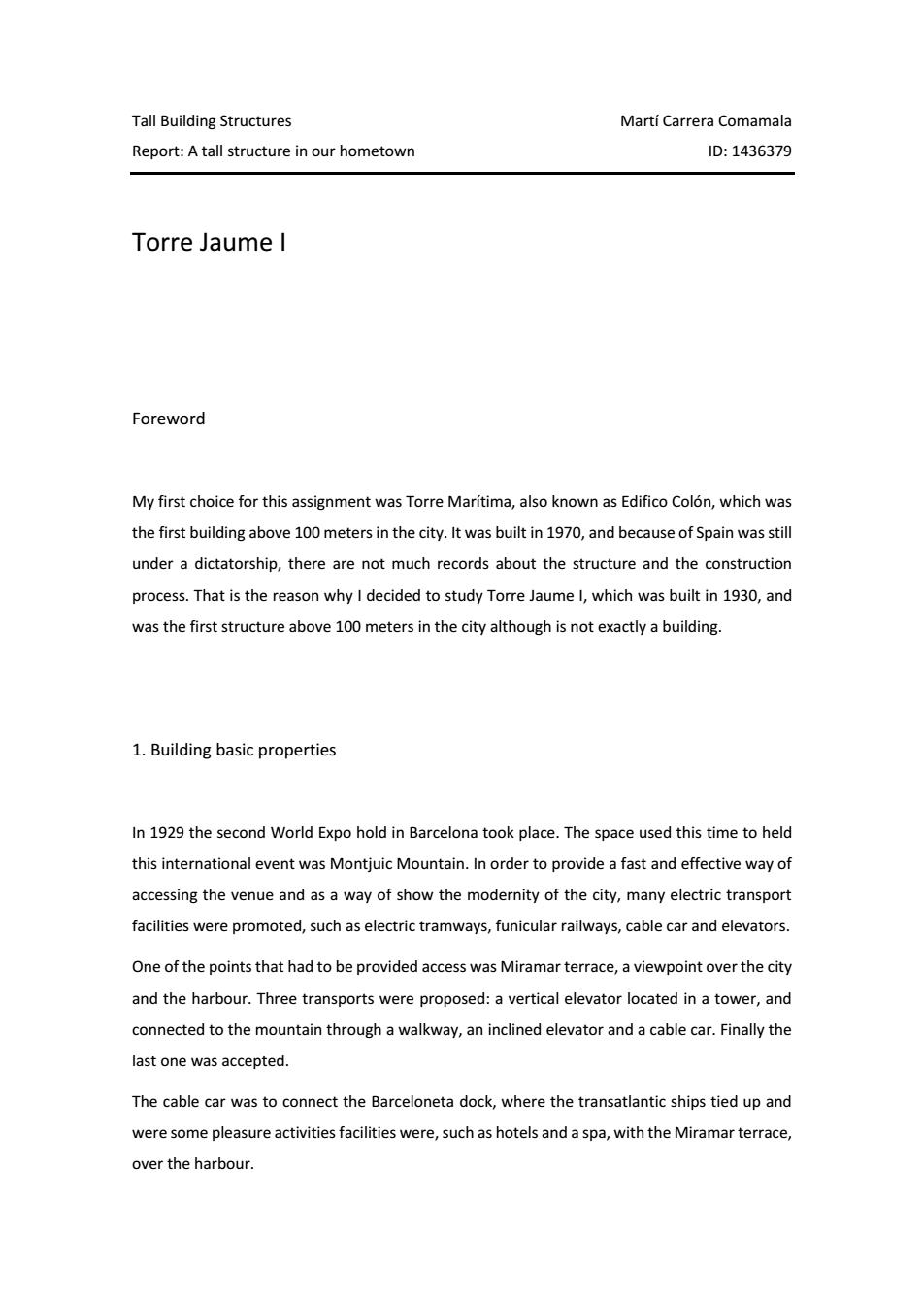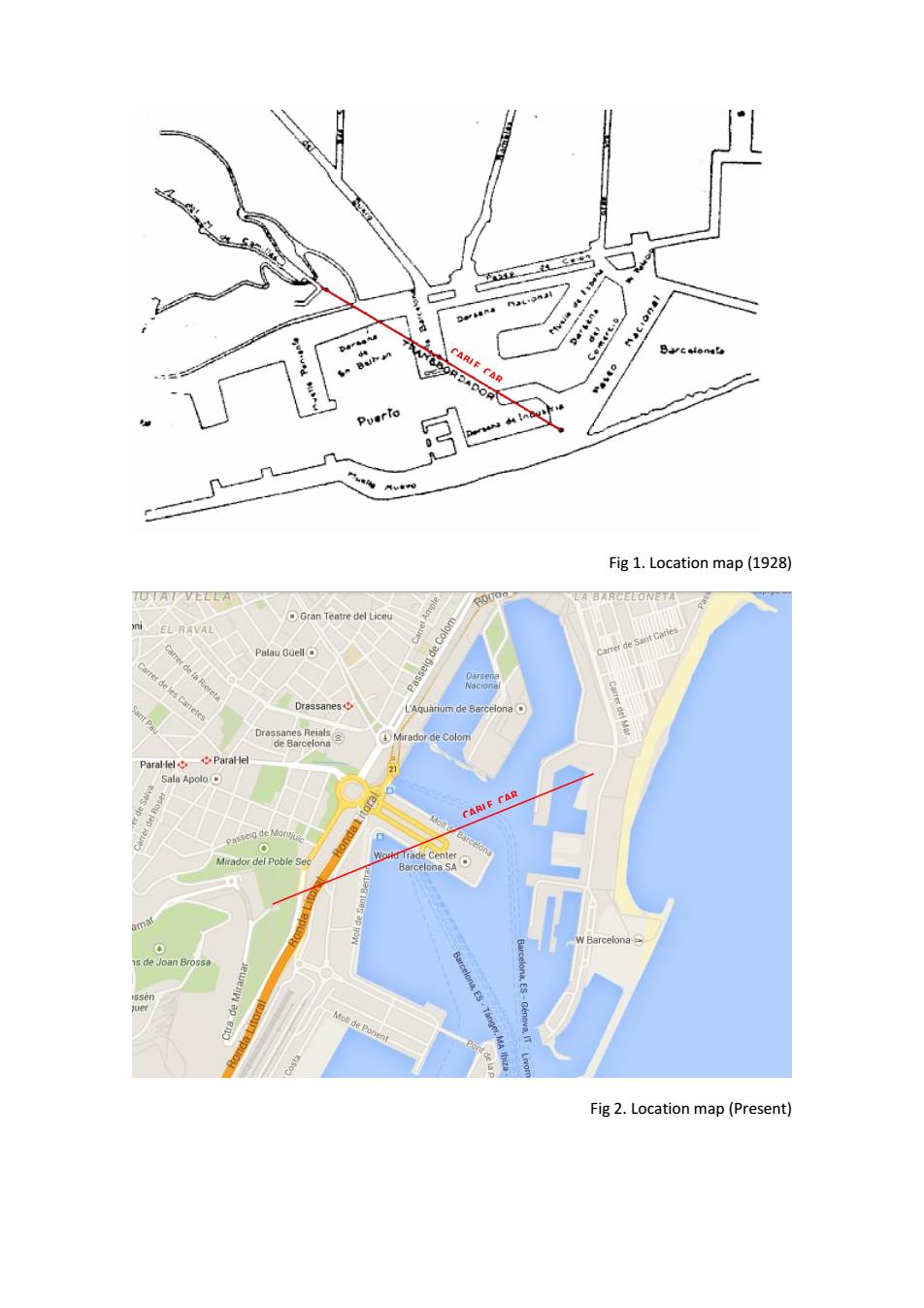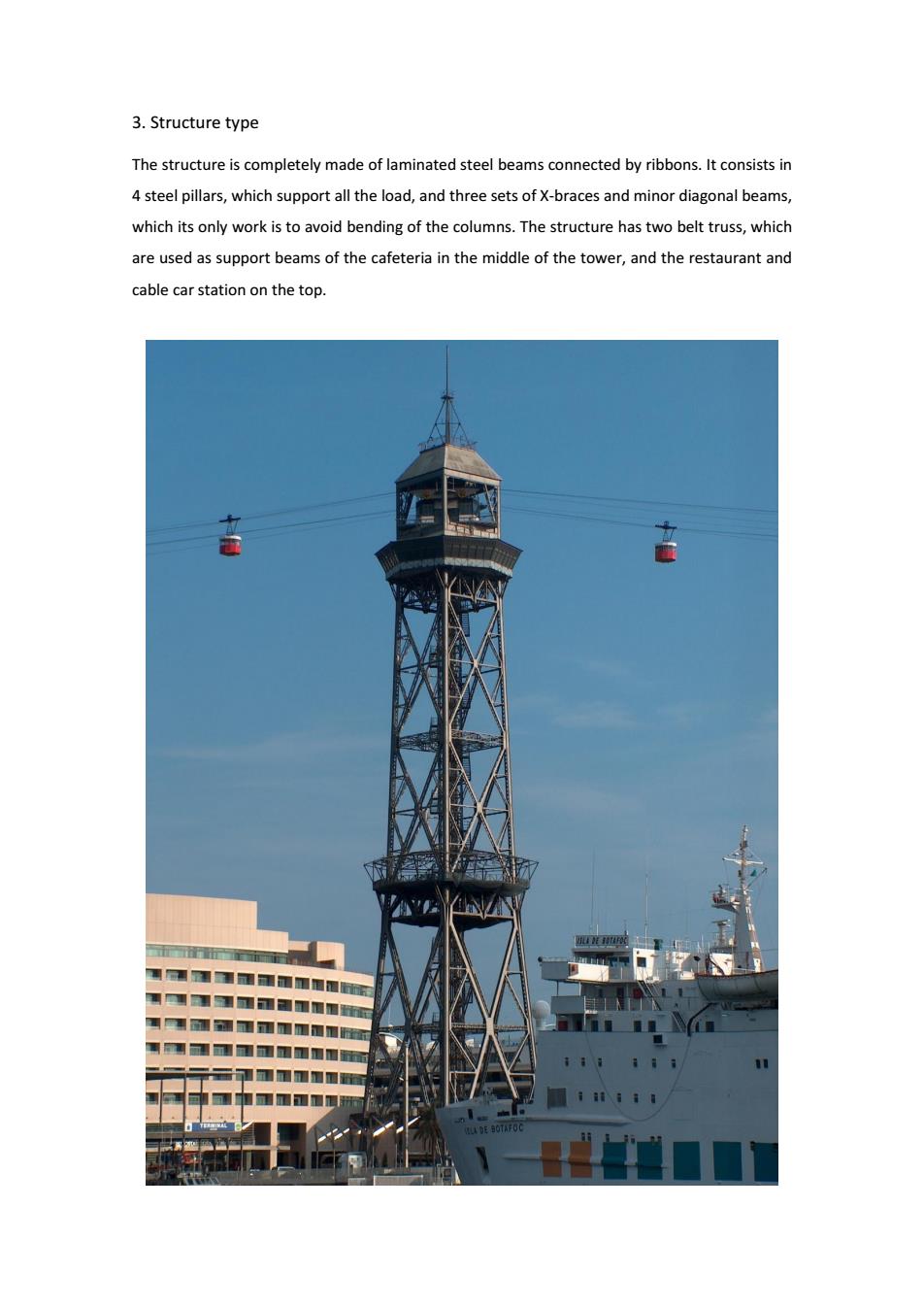
Tall Building Structures Marti Carrera Comamala Report:A tall structure in our hometown I1D:1436379 Torre Jaume I Foreword My first choice for this assignment was Torre Maritima,also known as Edifico Colon,which was the first building above 100 meters in the city.It was built in 1970,and because of Spain was still under a dictatorship,there are not much records about the structure and the construction process.That is the reason why I decided to study Torre Jaume which was built in1930,and was the first structure above 100 meters in the city although is not exactly a building. 1.Building basic properties In 1929 the second World Expo hold in Barcelona took place.The space used this time to held this international event was Montjuic Mountain.In order to provide a fast and effective way of accessing the venue and as a way of show the modernity of the city,many electric transport facilities were promoted,such aselectric tramways,funicular railways,cable carand elevators One of the points that had to be provided access was Miramar terrace,a viewpoint over the city and the harbour.Three transports were proposed:a vertical elevator located in a tower,and connected to the mountain through a walkway,an inclined elevator and a cable car.Finally the last one was accepted The cable car was to connect the Barceloneta dock,where the transatlantic ships tied up and were some pleasure activities facilities were,such as hotels and a spa,with the Miramar terrace, over the harbour
Tall Building Structures Martí Carrera Comamala Report: A tall structure in our hometown ID: 1436379 Torre Jaume I Foreword My first choice for this assignment was Torre Marítima, also known as Edifico Colón, which was the first building above 100 meters in the city. It was built in 1970, and because of Spain was still under a dictatorship, there are not much records about the structure and the construction process. That is the reason why I decided to study Torre Jaume I, which was built in 1930, and was the first structure above 100 meters in the city although is not exactly a building. 1. Building basic properties In 1929 the second World Expo hold in Barcelona took place. The space used this time to held this international event was Montjuic Mountain. In order to provide a fast and effective way of accessing the venue and as a way of show the modernity of the city, many electric transport facilities were promoted, such as electric tramways, funicular railways, cable car and elevators. One of the points that had to be provided access was Miramar terrace, a viewpoint over the city and the harbour. Three transports were proposed: a vertical elevator located in a tower, and connected to the mountain through a walkway, an inclined elevator and a cable car. Finally the last one was accepted. The cable car was to connect the Barceloneta dock, where the transatlantic ships tied up and were some pleasure activities facilities were, such as hotels and a spa, with the Miramar terrace, over the harbour

Fig 1.Location map(1928) VELLA n de Fig 2.Location map(Present)
Fig 1. Location map (1928) Fig 2. Location map (Present)

The cable car had its initial station in Miramar terrace at ground level,and the terminus station on the dock located in a tower;it also had a central tower in Barcelona dock.It was first projected to have the cars travelling 45 meters above the sea level,and that caused a lega dispute between the promoters and the Harbour Authority,which wanted to have at least 60 meters of free space over the harbour waters.That made the project to be stopped and redesigned. Finally the Harbour requirements were satisfied,keeping the initial station at ground level and making the two towers taller,107m the middle one(the cable car station is at9 m)and 78.4 the terminus one.But the construction began too late and the cable car could not open until 1931,two years after the World Expo. Torre Jaume I(Jaume Itower)is the middle pier tower of the cable car.Located in Barcelona dock,inside Barcelona Harbour,was the first structure of the city to be over 100 meters:it is 107 meters high in total.Its construction began on 1929 and ended on1930. Apart from being the central support for the cross-harbour cable car,with the station 85 meters above the ground,it has a restaurant just underneath the cable car station and a cafeteria 40 meters below.Although the structure is in perfect state,due to the closure because of the Spanish Civil War(1936-1939)the restaurant and the cafeteria were closed and never opened again,although in recent years it has been mentioned many times to do so. The access to all the facilities of the tower is done through a unique elevator located in the centre of the tower. 2.Structure particularities Due to its basic function as a tall support for a cable car,almost the whole structure is hollow, and then there are no large wind loads.Also Barcelona has no seismic activity at all.It also has to be said that at the moment of its design,wind load,and lateral loads in general,were not usually taken into account when designing a structure
The cable car had its initial station in Miramar terrace at ground level, and the terminus station on the dock located in a tower; it also had a central tower in Barcelona dock. It was first projected to have the cars travelling 45 meters above the sea level, and that caused a legal dispute between the promoters and the Harbour Authority, which wanted to have at least 60 meters of free space over the harbour waters. That made the project to be stopped and redesigned. Finally the Harbour requirements were satisfied, keeping the initial station at ground level and making the two towers taller, 107 m the middle one (the cable car station is at 90 m) and 78.4 the terminus one. But the construction began too late and the cable car could not open until 1931, two years after the World Expo. Torre Jaume I (Jaume I tower) is the middle pier tower of the cable car. Located in Barcelona dock, inside Barcelona Harbour, was the first structure of the city to be over 100 meters: it is 107 meters high in total. Its construction began on 1929 and ended on 1930. Apart from being the central support for the cross-harbour cable car, with the station 85 meters above the ground, it has a restaurant just underneath the cable car station and a cafeteria 40 meters below. Although the structure is in perfect state, due to the closure because of the Spanish Civil War (1936-1939) the restaurant and the cafeteria were closed and never opened again, although in recent years it has been mentioned many times to do so. The access to all the facilities of the tower is done through a unique elevator located in the centre of the tower. 2. Structure particularities Due to its basic function as a tall support for a cable car, almost the whole structure is hollow, and then there are no large wind loads. Also Barcelona has no seismic activity at all. It also has to be said that at the moment of its design, wind load, and lateral loads in general, were not usually taken into account when designing a structure

3.Structure type The structure is completely made of laminated steel beams connected by ribbons.It consists in 4 steel pillars,which support all the load,and three sets of X-braces and minor diagonal beams, which its only work is to avoid bending of the columns.The structure has two belt truss,which are used as support beams of the cafeteria in the middle of the tower,and the restaurant and cable car station on the top
3. Structure type The structure is completely made of laminated steel beams connected by ribbons. It consists in 4 steel pillars, which support all the load, and three sets of X-braces and minor diagonal beams, which its only work is to avoid bending of the columns. The structure has two belt truss, which are used as support beams of the cafeteria in the middle of the tower, and the restaurant and cable car station on the top

4.Other interesting points During Spanish Civil War it was used as a machine gun spot to defend the port. The tower is the second tallest cable car pylon in the world
4. Other interesting points During Spanish Civil War it was used as a machine gun spot to defend the port. The tower is the second tallest cable car pylon in the world